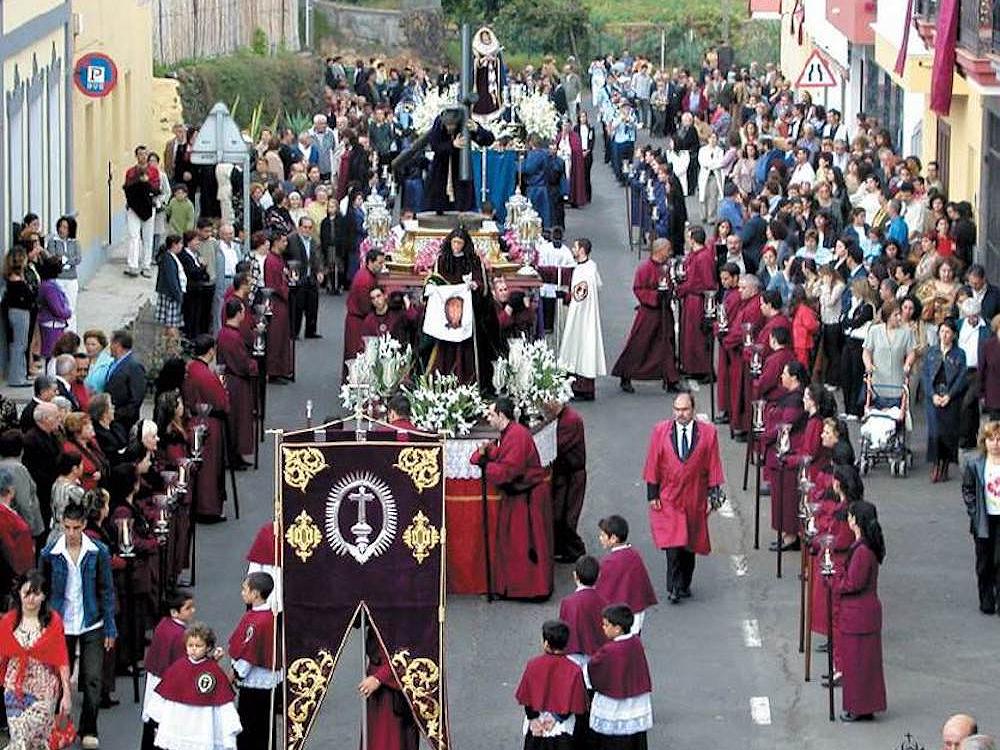
Plan to spend your Easter holidays at your exclusive property on Tenerife, Spain? If you have the fortune to enjoy a few days of rest at Abama, remember that this is a wonderful time to step out of your usual paradise and learn a bit more about the religious folklore of one of the busiest of the Canary Islands. Last year we encouraged you to explore the Holy Week celebrations in San Cristobál de la Laguna, La Orotava, and Adeje, and this year we will round out our recommendations with a few additional things to discover. Ultimately, we hope to help deepen your knowledge of this interesting part of art history and make these traditions exciting.
The capital, Santa Cruz, is the centre of it all
100 km from your exclusive property in Tenerife, Spain, or just over an hour by car, you’ll find the Santa Cruz de Tenerife Holy Week celebrations, whose processions have the honour of being among the oldest and most well known of the archipelago. Their celebration began after the conquest of the islands in 1496, in line with the establishment of religious brotherhoods that sprang up around the first parochial communities.
Almost 40 religious acts will take place between the beginning of Lent and Easter Sunday. Among them, some of the highlights will be the procession of the Esperanza Macarena, which is carried on the shoulders of the “costaleros” or “cargadores” from the Church of the Conception on Holy Thursday; and the procession of the Cristo Cautivo, which leaves the same church carried by women, something that is rather unusual in the Spanish Holy Week tradition. Another interesting and unmissable event is the procession of the Señor de las Tribulaciones, which traverses the city on Holy Tuesday.
Güimar, impressive historical artistic creations
Very close to Santa Cruz, on the other end of the island, you’ll find the Holy Week celebrations of Güimar. The trip is worth it if you want to discover the many “tallas” – wooden art sculptures of the characters from the Passion of the Christ – created by artists since the Baroque era. Standouts include the “Virgen de las Aguas” by the Cordoban Francisco Romero Zafra; the “Cirineo” by Güimarean Javier Eloy Campos; and the “Nazareno”, which dates to the end of the XVII century.
One of the most attractive parts of the celebrations of Güimar is the Vía Crucis, whose protagonist is “Christo de la Expiración”, on Good Friday. You should be aware that on Tenerife, you can only see the re-enactment of Jesus’s path to the crucifixion here and in the municipalities of Adeje and Candelaria. Güimar’s Holy Week culminates with the Procesión Magna, in which all of the processions of all the brotherhoods in the municipality participate.
Los Realejos, two Holy Weeks
Our third suggestion is the celebration that is also closest to your luxury home on Tenerife: Los Realejos, less than 60 km from Abama Resort. Though Holy Week in the municipality was formerly one celebration carried out by three convents, after their disappearance in the XIX century, the icons were split between two parishes and the processions began to divide. Don’t miss this opportunity to see in person how each one has evolved.
The Apóstol Santiago parish is the one that has best weathered the sands of time and its processions continue to be carried solely on the shoulders of the “cargadores”. It combines ancient processions, like that of the “Resucitado”, on the morning of Easter Sunday, with recent additions like “Cristo de la Oración en el Huerto” on Holy Monday.
The other parish, that of Nuestra Señora de la Concepción, has had a more difficult time thanks to a fire in 1978 that destroyed its incredible trove of sculpture heritage. The incident didn’t dampen the community’s faith, though, and it’s worth seeing the icons that appear in the processions that have been created since the 1980s. The “Santísimo Cristo de la Redención”, for example, sets out at dawn on Good Friday for El Calvario, and returns the afternoon of the same day. This “talla” was donated by the sculptor Ezequiel de León Domínguez for the processions, but you can also see his “Señor de la Cañita”, “La Piedad”, or “El Nazareno”.
As you can see, the same religious tradition can take on many different forms according to the part of Tenerife, Spain in which you find yourself, and even in different parts of the same municipality. Abama Luxury Residences wishes only that, no matter which celebration you choose, you get the most out of this Holy Week by diving into some of the purest of traditions. Remember, there's always more fascinating Tenerife culture to explore!







